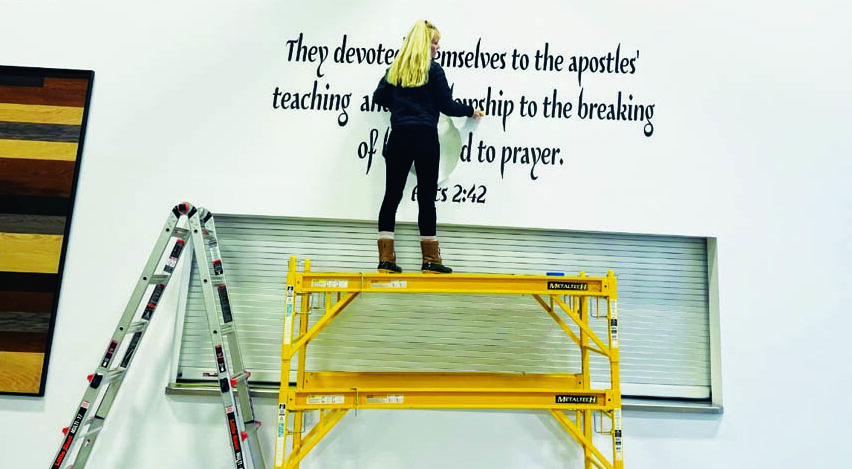Supply chain management is the backbone of any company, big or small, that deals in physical goods with substantial production and distribution processes. Over the past several years, supply chain professionals have faced unprecedented disruptions. A wide number of events, from the COVID-19 pandemic to geopolitical tensions to climate change, have caused significant shifts as well as disturbances to supply chains around the world.
For suppliers in the signage and printing industry, they must keep up with economic trends and make sure they have products in stock to meet customer demand. For shops, that means having the right materials in-house and on-hand so they can offer a variety of products to offer their clients for signage projects such as inks, plastics, aluminum, and lumber.
Will 2024 be a chaotic year for supply chains? How can companies adapt to not only survive, but to thrive amid shifting conditions? What will be some of the big trends to arise during the year? We polled a number of companies to answer these questions and more on this critical topic.
Dealing with shortages and changes in the market
“Although transportation issues have stabilized, we continue to suffer shortages in critical electronic components such as microchips, circuit boards, and high-precision motors,” says Amado Lara, president at Roland DGA in Irvine, California. “Because we use high quality and highly specialized components, there are a limited number of manufacturers and sources available globally. The recent technology boom in the last few years has caused high demand for these types of components, especially in the consumer product sector,” he adds.
Lara notes that these shortages have an effect across the entire range of the company’s portfolio, from wide-format printers to vinyl cutters. “We have also seen shortages in the raw materials used to produce the different types of inks our products use. The impact is usually limited to specific colors due to the pigments and other components used to produce the ink, however broader shortages, even those involving the packaging, could affect availability.”
Lara points out that Roland DGA’s supply chain management and procurement departments constantly work to diversify their sources for these critical components.
“Previously, our strategy of relying on a handful of traditional suppliers and a certain volume of production was sufficient. Now, as we look to expand our product portfolio and the markets we serve, we see the need to expand our production capacity. This has required working with a wider range of suppliers to avoid critical delays in component deliveries. Our teams have begun seeking out new partners and sources, and as these new relationships are established, we should be able to create the redundancy needed to access to these parts and maintain consistent production.”

When asked about what shop owners should be doing to prepare for potential shortages/delays in products and media, Lara says that the best course of action customers and owners can take to protect themselves from potential shortages is to work closely with their dealer or distributor and provide a forecast of their production needs for at least a 90-day window.
“By doing so, the dealer or distributor can use that information to effectively manage their own inventories of product and media, assuring they will have sufficient short-term stock for their customers. In turn, this information is communicated up the chain and will allow the manufacturer to properly forecast customer needs. This is particularly important during higher periods of production, like around the holidays.”
Lara says that customers should also consider keeping short-term stock on hand. “As the manufacturer, we make sure we provide our customers with proper storage and expiration information, particularly on short shelf-life inks, so they can manage their inventory efficiently. Customers should also be aware of the lead times for hardware deliveries. When working with their dealer or distributor, they should make sure to inform them of their installation requirements to ensure any urgent delivery requirements are communicated to the manufacturer.”
Lara adds that due to increased demand for customized and personalized products and finished goods, there are more requests not only for the devices that can digitally print these items, but also for these promotional products themselves. “Particularly during peak seasons, customers need to be prepared for potential shortages of some of these promotional products. They should also be aware of any finishing requirements that may be impacted by shortages and availability. It’s important to keep in mind the consumption rates and inventory levels of certain lamination and finishing films, primers, and other surface treatments, finishing hardware, and additional supplies that could impact a shop’s ability to either deliver a finished good or complete a proper installation of a finished product.”
As far as trends for 2024, Lara says that sustainable products are growing in demand. “The trend toward using more sustainable materials and goods, particularly in the visual graphics industry, may increase demand for these types of products. With the global manufacturing of many of these items, customers should be mindful of long lead times and potential shortages. Also, the growth of digital applications and the increased range of specialty materials available to customers present additional challenges, especially when it comes to having consistent access and inventories of some of these products,” he says.
Specialty media category to grow in 2024
Lara adds that products such as holographic films, metallic media, and specialty garment transfer material may become increasingly popular, potentially making them more difficult to source. “Keeping these factors in mind, customers should plan ahead and consistently communicate with their dealer or distributor about their product and supply needs,” Lara concludes.
Keeping inventory on hand
An effective supply chain is crucial because it ensures a sign shop has continuous supplies, which allows them to stay competitive by meeting customers’ needs at a low cost while still ensuring profit margins remain healthy enough for long-term success.
“Overall, we noticed the shipping delays from the pandemic are back to normal. We have noticed some products that are manufactured in other countries tend to have shipping delays, such as custom tents and backdrops,” says Gina Lynch, owner of Great White Graphics in Johnson City, Tennessee. Great White Graphics is a boutique sign business that focuses on quality service and products.
“Due to labor shortages, outsourcing promotional products tend to take longer than usual to arrive, which we believe will continue,” she added.
Lynch says that making sure inventory is properly stocked is imperative for sign shops.
“We normally order more than we need of essential products to have on hand for daily use. Locally, we work with another trusted sign company in a town nearby. We’ll send some large-format work to them and in turn we do some of their banner projects. By doing this, it helps us concentrate on fewer materials to stock and cuts down on labor costs.”

She adds that national trade-only wholesalers are also a good backup plan. “Having a large company that does certain products and ships right to your door is a great way to free up your employee’s time.”
Lynch says that with the election season fast approaching, political signage is a big trend for 2024. In addition, digital signage is always in demand and growing yearly. “Since COVID, safety signage has increased each year and should continue to do so. Promotional products are always a hit and a great way to work with your current loyal businesses.”
She points out that today people are busier than ever. “If you have the manpower, we’ve found offering a local delivery service gives our customers more freedom and it allows you to interact and thank them in person. We’ve noticed this service growing each year. The new year brings new activities and goals for living healthier lifestyles. Sports such as pickleball are growing exponentially. Focusing on local team sports is a good way to grow your signage business for the upcoming year,” she predicts.
Paul Pace, CEO and founder of Pace GFX in Plano, Texas, notes that inventory levels in the Dallas area have been back to normal for a couple of years now. “We get the vast majority of what we order the next day. Shop owners should find better suppliers if that isn’t the case,” he says.
Pace forecasts that in 2024, there will be more experiential branding projects in the office space that extends further than basic wall wraps and posters on the wall. “People want intricate designs that showcase their brand in a more artful way,” he says.
No delays in New Orleans

“I don’t really have any problems getting what I need. If there are any delays, it maybe just be an extra day or two as its not in stock at my local distributors warehouse,” says Kevin Kempf, master installer and lead designer at PG NOLA, a New Orleans, Louisiana-based graphic, design, and installation company.
The shop specializes in custom color change and commercial vehicle wraps for cars, trucks, boats, and recreational vehicles. “I don’t really have any problems getting what I need. If there are any delays, it may be just an extra day or two as its not in stock at my local distributor’s warehouse.”
Kempf advises if you can afford to, stock up on the media you use most. “I like to have three or four rolls of extra print media kits on hand at all times.”
One big trend Kempf is seeing at his business is more of a demand for custom door jamb designs. “Its not just a color match thing I am talking about a hard contrast, open the door and say ‘WHOOOOAAAAA’ kind of door jamb. Something that really catches someone’s attention when the door opens like I have on my 1966 Coupe DeVille as well as two vehicles we are finishing up this week in my shop. All three have wild jambs that make a statement!”
Keeping close relationships with suppliers
Matt Baker, co-owner and operator at Bakers’ Signs and Manufacturing based in Conroe, Texas, says that when it comes to inventory, his shop relies on their suppliers to fill the gaps with the right products as well as at the right times.
“Simply stated, it’s their job. As a company we try and keep close relationships with multiple vendors. We also don’t keep all our eggs in the same basket and try to ensure we always pay them without them needing to chase their money. We find that in doing so, they will fight for us when needed. Over the last three years we have raised our on-hand inventory to help with some of the materials’ longer lead times. This helps our suppliers and also helps our business in the process.”
He adds that shops like his are also in tune with the manufacturers of their products, keeping competition real as well as also keeping larger amounts of inventory on hand.
Baker says that shop owners need to make sure to keep the right people in the right places. “Don’t get complacent with these aspects. Times change, companies change and so do the people that work at them. Some are for the better and some for the worse. Always be open-minded to change. Embrace it, and always try to raise the bar. Ensure that you are working with the right clients, and know who your clients are. When you can merge the right employees with the right clients, we tend to see that all works together for the better!”
He said pricing is also an issue especially for hardware. “Equipment as a whole has gone crazy! Prices and leads times are just on the next level. However, we need it. We have no choice to pay what they are asking for such and will wait for as long as we need to. The only other option is to run and maintain the older equipment and that also, can be a vicious cycle.”
He advises other shop owners to fight the good fight, keep your options open and keep the faith that it will get better in that regard. Above all, we should do anything we can do to mitigate how much we are relying on others’ schedules and product availability “We find ourselves in many instances buying equipment that is one year or more out within delivery. In some cases, it can be even longer than that. You should plan as needed.”
Baker said that customer service seems to be a thing in the past. “If you can keep your team on their A-game in terms of this trait, you will likely stay in demand with your clients. Costs seem to be rising across the board and the rates that sign companies are charging should be right there with it. Workers’ overall motivation and general attitudes are also at an all-time low. Employers need to get creative with keeping all their employees plugged in, moving forward, and energized to be at work. We find investing heavily in this regard has paid dividends,” Baker concludes.





